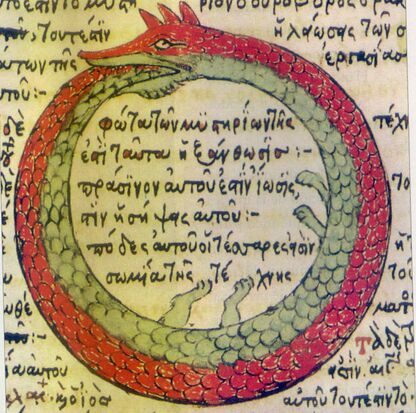In the metabolic process of content production, generative AI operates as an Autophagic organism. Autophagy in biological systems can be summarized as “a natural process in which the body breaks down and absorbs its own tissue or cells.”(AUTOPHAGY | English Meaning - Cambridge Dictionary, n.d.) In cells, this mechanism is dedicated to maintaining the system's internal balance and self-optimization, but its malfunction can give rise to nefarious consequences for the operation of the organism.(Parzych & Klionsky, 2014) In the ecology of generative media, the flow of information through the body of the model transfigures inputs, with its algorithm-defined molecular mechanism of data acquisition toward outputs that feed into a circuit that engenders an impossible state of homeostasis.

In a cultural analogy, this autophagic mechanism of media content production with generative AI recalls the archetypal symbol of Ouroboros. The mythological snake eating its own tail, vastly associated with Jungian psychoanalysis, hints at this process of self-actualization toward which machine learning models are prompted through data mining in a statistical attempt to encode the real.
In Jung's own words: “The Ouroboros is a dramatic symbol for the integration and assimilation of the opposite, i.e. of the shadow. This 'feedback' process is at the same time a symbol of immortality since it is said of the Ouroboros that he slays himself and brings himself to life, fertilizes himself, and gives birth to himself. He symbolizes the One, who proceeds from the clash of opposites, and he, therefore, constitutes the secret of the prima Materia which ... unquestionably stems from man's unconscious.”(Jung & Jung, 1970)
The shadow is a phenomenon that also occurs in large language models (LLMs), a nuanced and often overlooked aspect that can potentially disrupt our cognitive landscape. Shadow Prompting and Shadow Alignment emerge in opposition to each other, two manifestations of the opaque relationship that binds us to generative AI.
“The increasing open release of powerful large language models (LLMs) has facilitated the development of downstream applications by reducing the essential cost of data annotation and computation. To ensure AI safety, extensive safety-alignment measures have been conducted to armor these models against malicious use (primarily hard prompt attack). However, beneath the seemingly resilient facade of the armor, there might lurk a shadow. (…) these safely aligned LLMs can be easily subverted to generate harmful content. Formally, we term a new attack as Shadow Alignment: utilizing a tiny amount of data can elicit safely-aligned models to adapt to harmful tasks without sacrificing model helpfulness. Remarkably, the subverted models retain their capability to respond appropriately to regular inquiries.”(Yang et al., 2023)
This is referred to as Shadow Prompting.(Salvaggio, 2023) More specifically, when inputting a prompt, LLMs employ encoding and decoding procedures to ensure that the generated content is in line with a specific narrative and ideology. To subvert this castration some users, have begun experimenting with methodologies to cheat the algorithm, hack it if you will. The Hacker succeeds in getting the desired/undesired content by overriding moderation/censorship through an attack called Shadow Alignment.
The intent of this discourse is to expose the role of generative media that enter the flow of the machinic unconscious (the social structures embedded in the training dataset) of content by reterritorializing the relations of production.(Guattari, 2011) What subversive forms of Hyperreality is this model likely to produce?